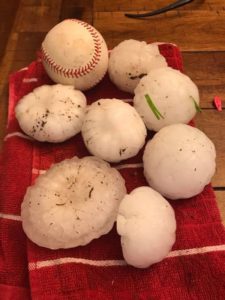 Ever been in a hail storm? If you have, you know it’s not fun, especially if you are stuck on the road. Hail can cause a lot of damage depending on its size, and it’s hard to predict when it will hit, although certain areas are more prone to hailstorms than others. Midland is flat and prone to heavy winds, so hail storms happen there fairly often. But it was the size of the hail from a storm just last week that was different. As you can see in the picture, the hail was equivalent to the size of a baseball — that’s massive!
Ever been in a hail storm? If you have, you know it’s not fun, especially if you are stuck on the road. Hail can cause a lot of damage depending on its size, and it’s hard to predict when it will hit, although certain areas are more prone to hailstorms than others. Midland is flat and prone to heavy winds, so hail storms happen there fairly often. But it was the size of the hail from a storm just last week that was different. As you can see in the picture, the hail was equivalent to the size of a baseball — that’s massive!
So what exactly is hail and how does it form?
According to National Geographic, “Hailstones are formed by layers of water attaching and freezing in a large cloud. A frozen droplet begins to fall from a cloud during a storm, but is pushed back up into the cloud by a strong updraft of wind. When the hailstone is lifted, it hits liquid water droplets. Those droplets then freeze to the hailstone, adding another layer to it. The hailstone eventually falls to earth when it becomes too heavy to remain in the cloud, or when the updraft stops or slows down.”
Basically, the larger the updraft, the larger the hail will be. For golf ball sized hail, the updraft needs to be at least 37 mph. For the baseball size hail that Disaster America saw in Midland, the winds that formed the updraft were going faster than 100 mph! Also, the bigger the hail, the faster it falls back down to earth.
How much damage can hail cause?
Hail can cause extensive damage, no matter the size. The average hailstorm lasts 5-10 minutes, which is a long time for balls of ice to fall down from the sky. Weather Underground states that hailstorms amount to $1 billion in property and crop damage each year.
Hail can cause:
Roof damage: The first thing hail will hit is the roof, whether it’s the roof of your home or your commercial property. This is the most common type of damage associated with a hailstorm. Roof damage can be dangerous, because unless you have a professional inspect the roof, you might not know the damage is there. And the longer roof damage goes without being fixed, the worse and more expensive the issues become.
Automobile damage: Hail storms are unexpected. If they can’t be predicted, then people don’t stay off the roads, which can be especially dangerous. Hail can cause damage to the exterior of the car, as well as the windows. And in severe cases, they can even cause damage to the car’s frame.
Property damage: Hail has been known to break tree limbs and can destroy bushes and plants. If the hail is large enough, it can even cause flooding as it starts to melt.
Window and siding damage: Hail doesn’t always fall straight down from the sky. Depending on the wind, it can fall sideways. When this happens, damage can occur anywhere on your property. Windows can crack or break, and the siding of a home or commercial property can become damaged.
Personal damage: If you are outside during a hailstorm and unable to take cover, there is a chance you could be seriously hurt. Hail has been known to cause welts and cuts on the skin, and in extreme cases can cause a concussion.
How to stay safe during a hailstorm
When hail starts to form and fall, there will be no warning. The best thing to do in this situation is to take immediate cover if you are outside. And if you’re driving, stop your car under an overpass or try to get home as soon as possible. Luckily for the Disaster America team, everyone was able to quickly take cover and no one was hurt.
If there is hail in your area, it’s important to thoroughly inspect your property once the storm has passed, especially the roof. As we mentioned before, roof damage will be the hardest type of damage to detect, so make sure you have a reputable company take a look.
